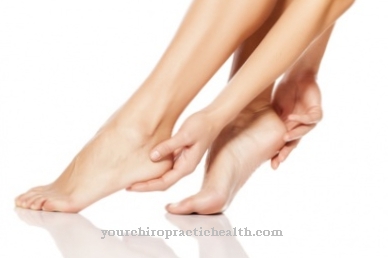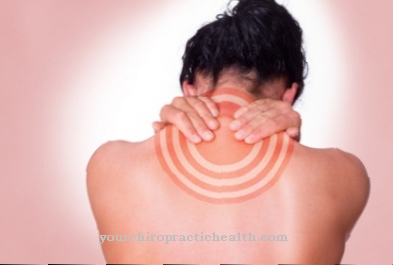Skin thickening can have various causes, the most common being disorders of the sebum glands and the protective cornea. As a result, not all skin thickening needs to be treated.
What is skin thickening?

The skin is the most important functional organ in humans, it serves to protect against external influences, as a covering for the inner body and performs important tasks in the human metabolism.
Although the skin itself is protected by its various layers, hair, horny layers and other components, skin diseases can develop. A rarely occurring skin disease is the thickening of the epidermis, the upper skin.
This usually occurs as a symptom and complication of another disease than lichenification, tyloma and sebostasis can be seen as medically significant in its occurrence.
With sebostasis, the sebum glands secrete too little sebum, which causes the skin to lose water and appear thickened. Lichenification is the thickening of the skin that occurs with chronic skin diseases; it is particularly typical for neurodermatitis. The physician uses Tylom to describe the thickening of the skin known colloquially as the cornea.
causes
The causes of the skin thickening must be differentiated according to the underlying disease.
In the case of skin thickening, for example, the development of skin cells is disturbed due to mechanical stress and inflammation. The skin cells suffer a shortened life cycle or inadequate removal of dead skin cells, the cell walls thicken or they multiply excessively.
A thick layer of the cornea, medically called cornification disorder, is the result. This is visually conspicuous, but serves to protect the layers of skin underneath it and is therefore to be seen positively at first. Corneal thickening usually occurs on the soles of the feet and palms, which are particularly stressed in everyday life, but are possible on all skin areas.
Lichenifications are caused by long-lasting mechanical, inflammatory or chemical over-irritation of the skin, for example in the case of neurodermatitis or allergies.
Sebostasis is attributed to insufficient sebum production, which usually occurs as a sign of aging.
Diseases with this symptom
- Neurodermatitis
- eczema
- psoriasis
- allergy
- Muckle Wells Syndrome
- Seborrheic keratosis
- Basal cell carcinoma
- Lipoma
- Knot rose
- Pityriasis rubra pilaris
- Circumscribed scleroderma
- Seborrhea
- Hair follicle inflammation
- tumor
- Myxedema
Diagnosis & course

If the person concerned notices thickening of the skin that cannot be explained by mechanical overstimulation and the resulting cornea, or that appears to be very severe, he should see a dermatologist.
This will first create a detailed anamnesis in order to find out side effects of the skin thickening, possible underlying diseases, possible causes and the time at which the symptom first appeared. This is followed by an optical examination of the affected skin areas and, if necessary, the measurement of the skin density. This is done either as an estimate with the naked eye or with aids such as a ruler.
Concrete diagnoses are usually already apparent during the examination, since the forms of the skin thickening differ and have a typical appearance. For example, lichenifications are accompanied by an enlarged field and a local thickening of the skin is noticeable in the cornea.
Complications
If left untreated, skin thickening is often perceived as a cosmetic blemish. Discomfort and a reduction in well-being set in. The affected parts of the body are hidden, which can lead to a feeling of restriction in everyday life.
If it is not possible to cover the thickening of the skin with clothing, it is usually out of shame that you change your own body language. Shaking hands is avoided, for example, or a greater distance from another person is built up. This can cause incomprehension and be understood as a rejection.
At the affected parts of the body, there is usually a reduced perception of stimuli. This can be found both pleasant and uncomfortable. If the skin thickening is caused by a skin disease such as neurodermatitis, then in most cases long-term medication is used. These have side effects and can thus trigger new complications.
Skin thickening can be associated with the formation of calluses. These are usually triggered by excessive stress in the corresponding region. The removal of the cornea therefore usually leads to a new formation. It would be advisable to check the existing stress or to check for poor posture. If there is inflammation, it is usually treated with tablets. Here too, side effects can occur. Organs can be affected or an intolerance can have corresponding effects.
When should you go to the doctor?
There can be different reasons for skin thickening. What does it depend on whether medical treatment is required? When is skin thickening a symptom and when is it an independent disease?
The skin as a covering of the body acts as a demarcation from the outside world. It consists of several layers. Skin diseases such as thickening of the epidermis, the so-called epidermis, can already occur here. This thickening of the skin is a symptom, for example of sebastosis, in which the sebum glands do not release enough sebum, causing the skin to lose fluid and appear thickened. Skin thickening in atopic dermatitis and various skin irritations and skin allergies are known. All of these skin conditions should be presented to a dermatologist.
The cornea is also one of the skin thickenings. Here you can first try to remove some of the corneal thickening with your own measures such as filing or the corneal loosening agents from the pharmacy. If this is difficult or if your skin is damaged, it is time to see a doctor. Occasionally, skin thickening can appear as a lump. Then a visit to the doctor is definitely recommended, because in addition to benign thickenings there are also malignant growths that must be treated as quickly as possible.
Doctors & therapists in your area
Treatment & Therapy
If the dermatologist has been able to make a clear diagnosis, he will, in consultation with the patient, initiate what he thinks is an adequate therapy. This, too, mostly depends on the cause of the skin thickening, for example atopic dermatitis requires the skin to be regreased and a sympomatic-systematic treatment.
The patient can usually treat the cornea himself by terminating the triggering stimulus and removing the cornea using pumice stones, corneal planes or corneal rasps. There are also corneal dissolving substances that can be used, salicylic acid and urea are the agents of choice. They dissolve the connections between the corneal cells, so that the breakdown is accelerated.
At the same time, the skin thins and becomes permeable to other drugs again. Urea also reduces skin growth and binds water in the horny layer, making it smoother and more delicate.
Salicylic acid has an antibacterial and anti-inflammatory effect, skin irritations can heal faster. In rare cases, the thickening of the skin is so strong and visually disturbing that surgical removal is necessary. However, some professional groups also value calluses as protection when carrying out their work, for example gardeners and guitarists.
Outlook & forecast
Thickening of the skin does not always lead to symptoms, so that it does not necessarily have to be treated by a doctor. The thickening of the skin leads to a decreased self-esteem in some patients. Often the skin thickening is a cosmetic defect and the person concerned feels uncomfortable and unattractive with the symptom. This leads to restrictions in everyday life and sometimes to breaking off social contacts. Psychological problems rarely arise, but they are just as possible.
Due to the thickening of the skin, external stimuli can no longer be properly perceived. This can lead to dangerous restrictions, as cold and warmth are not properly perceived. If the skin thickening occurs due to an allergy or an intolerance, it usually disappears when the respective ingredient has been completely broken down by the body. Medical treatment is aimed at avoiding these ingredients or taking certain medications that can prevent the symptom.
In many cases, skin thickening can be treated at home with rapid success. If the skin thickening persists and does not go away through self-help, medical advice is necessary. In this case, it could be a different condition.
prevention
The regeneration of the skin can be supported regardless of the underlying disease. Creams, ointments and water-oil emulsions are used here as basic therapy and at the same time to prevent skin diseases.
You can do that yourself
Since skin thickening can have a wide variety of causes, it does not have to be treated in every case. A classic cause is, for example, the thickening of the corneal layer, which is also known as a cornification disorder, but which only serves to protect the skin. This cause of skin thickening does not have to be treated by a doctor, only the dead corneal layer has to be removed with pumice stones, corneal planes or corneal rasps. Substances such as salicylic acid or urea can also prove to be helpful, since connections between the corneal cells dissolve and thus the breakdown is accelerated. Once this layer has been removed, the skin begins to thin out again and is again acceptable for other drugs.
Urea is particularly helpful with an increased form of skin thickening, as it also reduces skin growth and then binds water to the corneal layer, so that the skin becomes smoother and more tender. Salicylic acid, on the other hand, is made for a normal case of skin thickening. Since this has an antibacterial and anti-inflammatory effect, the skin irritations can heal faster and the skin can regenerate better.
It is also recommended to avoid extreme cold or heat as much as possible. The reason for this is that stimuli can no longer be perceived well enough. Because of this, the thickening mostly disappears if extreme temperatures are avoided.

















.jpg)







.jpg)


